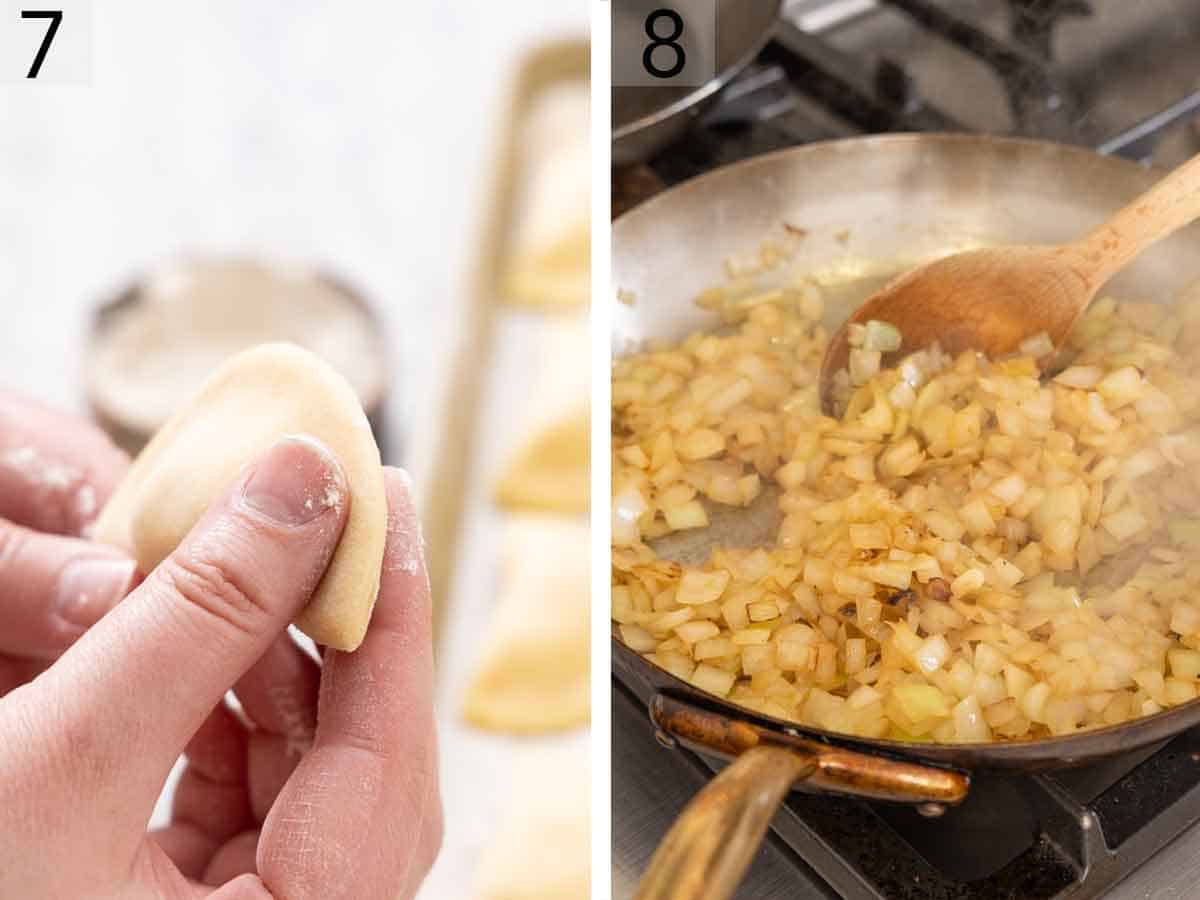You can’t beat homemade pierogies–these savory, chewy dumplings are made by stuffing a simple pierogi dough with a cheesy potato filling. Then, the dumplings are boiled in water to cook them, pan-fried until golden brown for a crispy finish, and topped with buttery caramelized onions.
Pierogies are traditionally served in Eastern Europe as a meal or paired with stew. While they take a little time to make, I will take you step-by-step through the process of making the best pierogi dish! For more potato recipes, try my homemade gnocchi, potato soup, or potato pancakes.
What Are Pierogi?
Pierogi are Polish dumplings made with pillowy dough and stuffed with either a savory or sweet filling. Their traditional version, called pierogi ruskie, is filled with fresh quark, a European tangy farmer’s cheese, and potatoes and is topped with fried onions to serve. In my recipe, I use cheddar cheese for an accessible American twist, but if you can find quark, you can certainly use it!
Ingredients

Russet Potato — this starchy potato creates the perfect fluffy pierogi filling. Alternatively, swap with Yukon gold potatoes if you don’t have Russet potatoes.
Unsalted Butter — adds a rich flavor to the filling and is used to caramelize the onion topping.
Sour Cream — this adds a tangy creaminess to the filling. Make sure you have extra to serve with the cooked pierogies!
Cheddar Cheese — shredded cheddar cheese gives the filling a sharp, savory flavor and creamy texture when melted. You could also make a decent substitute for the traditional farmers cheese by using drained large curd cottage cheese or ricotta.
Onion — yellow onions develop a sweet and nutty flavor when caramelized with butter. Alternatively, use white onion for a milder flavor or red onion for a sweeter taste.
How To Make Pierogi

1. In a large bowl, whisk together the flour and salt. Make a well in the center of the mixture. In a liquid measuring cup, whisk together 1⁄2 cup of water, vegetable oil, and egg. Pour the mixture into the well in the flour mixture and stir it with a wooden spoon until a shaggy dough forms.
2. Scrape the dough from the bowl onto a lightly floured surface and knead it together until smooth, for about 6 minutes, sprinkling with additional flour as needed. Wrap the kneaded dough with plastic wrap and let it rest at room temperature for 1 hour.

3. Meanwhile, peel and cut the potato into 1-inch pieces. Place them in a small pot and cover with cold water by 1 inch. Season the water with salt. Bring the large pot of salted water to a boil over medium-high heat, then reduce the heat to medium. Simmer the potatoes for about 12 minutes, until they are fork tender.
4. Drain the potatoes and return them to the pot. Add the butter, sour cream, salt, and black pepper to the pot. With a potato masher, mash the potatoes until they are very smooth. Place them in a large mixing bowl. Stir in the cheese until just combined. Spread the mixture out on the bottom and around the inside of the bowl. Let it cool until it’s barely warm, for about 45 minutes, stirring the mixture and spreading it occasionally.

5. Divide the dough into two pieces. Lightly flour a surface and a rolling pin. Working with one piece of dough at a time, roll the dough into a large piece, about ⅛-inch thick. Use a 3-inch round biscuit or cookie cutter to cut 10-12 circles from the dough. Knead the dough scraps together until it is a smooth ball. Wrap it in plastic wrap and let it rest for 15 minutes. Re-roll and cut this dough one more time.
6. Fill each circle with about 1½ teaspoons of the potato filling mixture. Brush the inside edges of the dough with water and fold them in half over the filling, pressing out any air in the interior.

7. Press the edges all around to seal or crimp the edges with a fork. As each pierogi is sealed, transfer it to a sheet tray lightly dusted with flour, arranging them in a single layer.
8. Place 2 tablespoons of butter in a large skillet and heat it over medium-high heat. When the butter begins bubbling, add the onions and salt. Cook for 5 minutes, stirring frequently, until the onions soften and start to brown on the edges. Reduce the heat to medium and cook, stirring frequently, for about 10 minutes, until the onions are golden brown. Remove the onions from the heat.

9. Working in batches, add 8-10 pierogi to a large pot of boiling water. Reduce the heat to medium to maintain a low boil and cook for 2-3 minutes until the pierogi floats to the top of the pot and the dumplings are tender but still chewy.
10. Transfer the pierogi with a slotted spoon or a spider to the skillet with the onions. Repeat with the remaining pierogi. Return the skillet with onions and pierogi to medium heat. Cook for 3-4 minutes to rewarm, stirring gently to combine. Add another tablespoon of butter if the pierogi sticks to the skillet. Season with salt and pepper to taste.

Can I Use Leftover Mashed Potatoes?
Yes! Leftover mashed potatoes make a great pierogi filling. You’ll need 1 ½ cups to replace the cooked potato. If your mashed potatoes are seasoned already, I suggest warming them slightly, then stirring in the cheese only (omit other ingredients) until it is just combined. Then, continue the recipe as outlined.
How To Serve Them
Enjoy pierogi topped with a dollop of sour cream and caramelized onions for a classic meal, or top with homemade gravy or candied bacon bits for an extra indulgent touch.

Can I Assemble The Pierogi Ahead Of Time?
Yes, you can assemble the pierogies and store them in an airtight container in the refrigerator for up to 24 hours or freeze them uncooked for up to 3 months. When you are ready to cook them, boil them as directed in the recipe.
How To Freeze Pierogi
- Uncooked pierogi: Place the assembled pierogi in a single layer on a lined baking sheet with space between them. Place in the freezer for 1-2 hours until completely frozen. Then, transfer the pierogi to a freezer-safe container and store them for up to 3 months. Boil them from frozen, adding a couple of minutes to the cooking time.
- Cooked pierogi: Allow the cooked pierogi to cool completely to room temperature, then place them in a single layer on a baking sheet lined with parchment paper with space between them. Freeze until solid, then transfer to a freezer-safe container and store for up to 2 months. Defrost them for several hours in the fridge, or add them to a skillet with a few tablespoons of water, cover, and simmer until heated through.
Pro Tips For Making This Recipe
- Use a triggered scoop. Use a small ½ teaspoon size scoop for easy and consistent filling measuring.
- Roll out the dough evenly. Use a rolling pin to roll the dough to an ⅛-inch thickness for the easiest shaping and even cooking.
- Avoid overworking the dough. Only re-roll the excess dough one time to prevent gluten from overdeveloping. If the dough snaps back when rolling it out, cover it with plastic wrap and let it rest for 15 minutes before proceeding.
- Quickly cool the potato filling. To save time, place the bowl of filling in the refrigerator uncovered until they are no longer steaming.
- Deglaze the onion pan. If the bottom of the frying pan gets too dark when caramelizing the onions, add water, 1 tablespoon at a time, to deglaze it, then reduce the heat slightly to continue cooking.

Frequently Asked Questions
Store cooled leftovers in an airtight container in the refrigerator for up to 3 days.
Heat butter or oil in a skillet over medium heat and sauté leftover pierogi until heated through and crisp, for 3-4 minutes on each side.
Unfortunately, this recipe cannot be made with prepared dough. If you need to save time, you can prepare the dough recipe ahead of time, cover it tightly in plastic wrap, and refrigerate it for up to one day. Bring it to room temperature for 1-2 hours before assembling the pierogi.
If you’ve tried this Pierogi recipe, then don’t forget to rate it and let me know how you got on in the comments below. I love hearing from you!

Pierogi Recipe
Equipment
- Rolling Pin
- Potato masher
- 3-inch round biscuit or cookie cutter
- Large skillet
- Large Pot
Ingredients
For the Pierogi Dough:
- 2½ cups all-purpose flour (300g)
- 1 teaspoon salt
- 4 teaspoons vegetable oil
- 1 large egg
For the Potato Filling:
- 1 russet potato (about 12 ounces, 340g)
- 1 tablespoon unsalted butter
- 1 tablespoon sour cream
- ¼ teaspoon salt
- ¼ teaspoon ground black pepper
- ¾ cup shredded cheddar cheese (85g)
To Serve:
- 4 tablespoons unsalted butter divided (56g)
- 2 large yellow onions chopped (750g)
- 1 teaspoon salt
- ½ teaspoon ground black pepper
- Sour Cream
Instructions
For the Dough:
- In a large mixing bowl, whisk together the flour and salt. Make a well in the center of the mixture.
- In a liquid measuring cup, whisk together 1⁄2 cup of water, the vegetable oil, and egg. Pour this into the well in the flour mixture and stir it all together until a shaggy dough forms.
- Scrape the dough from the bowl onto a lightly floured surface and knead it together until smooth, about 6 minutes, sprinkling with additional flour as needed. (The dough should feel moist and soft, but once it starts to stick to your hands or the surface, add another sprinkle of flour.)
- Wrap the dough with plastic wrap and let it rest at room temperature for 1 hour.
For the Filling:
- Meanwhile, peel and cut the potato into 1-inch pieces. Place them in a small pot and cover with cold water by 1 inch. Season the water with salt.
- Bring the pot to a boil over medium-high heat, then reduce the heat to medium. Simmer the potatoes for about 12 minutes or until they are fork-tender. Drain the potatoes and return them to the pot.
- Add the butter, sour cream, salt, and pepper to the pot. With a potato masher, mash the potatoes until they are very smooth. Place them in a large mixing bowl.
- Stir in the cheese just until combined. Spread the mixture out on the bottom and around the inside of the bowl. Let it cool until it’s barely warm, about 45 minutes, stirring the mixture and spreading it occasionally. (You can speed this up by placing the bowl in the refrigerator, uncovered, once the potatoes are no longer steaming. )
To Assemble the Pierogi:
- Divide the dough into two pieces. Lightly flour a surface and a rolling pin. Working with one piece of dough at a time, roll the dough into a large piece, about ⅛-inch thick.
- With a 3-inch round biscuit or cookie cutter, cut 10 to 12 circles from the dough. Set the dough circles on another floured surface (it’s ok if they overlap slightly).
- Knead together the excess dough (from the first and second rolls) until it is a smooth ball. Wrap it in plastic wrap and let it rest for 15 minutes. Re-roll and cut this dough one time to make more circles.
- Lightly flour a large, rimmed baking sheet and set it aside.
- Fill each circle with about 1½ teaspoons of the potato filling mixture.
- Brush the inside edges of the dough with water and fold them in half over the filling, pressing out any air in the interior. Press the edges all around to seal. (You can crimp the edges with a fork if you like.) As each pierogi is sealed, transfer it to the floured sheet tray in a single layer.
To Cook and Serve:
- Fill a large pot two-thirds full with water and place over high heat and bring it to a boil.
- Meanwhile, place 2 tablespoons of butter in a large skillet and heat it over medium-high heat. Once the butter is bubbling, add the onions and salt. Cook for 5 minutes, stirring frequently, until the onions start to soften and start to turn brown on the edges. Reduce the heat to medium and cook, stirring frequently, for about 10 minutes, until the onions are golden brown. (If the bottom of the pan gets too dark, add water, 1 tablespoon at a time, to deglaze.) Remove the onions from the heat.
- Once the water is boiling, season it generously with salt. Working in batches, add 8 to 10 pierogi to the pot. Reduce the heat to medium to maintain a low boil and cook for 2 to 3 minutes until the pierogi float to the top of the pot and the noodle is tender but still chewy. Transfer with a slotted spoon or a spider to the skillet with the onions. Repeat with the remaining pierogi.
- Return the skillet with onions and pierogi to medium heat. Cook for 3 to 4 minutes to rewarm, stirring gently to combine. (Add another tablespoon of butter if the pierogi stick to the skillet.) Season with salt and pepper to taste. Serve them immediately with some onions from the skillet and the sour cream.
Notes
- Use a triggered scoop. Use a small ½ teaspoon size scoop for easy and consistent filling measuring.
- Roll out the dough evenly. Use a rolling pin to roll the dough to an ⅛-inch thickness for the easiest shaping and even cooking.
- Avoid overworking the dough. Only re-roll the excess dough one time to prevent gluten from overdeveloping. If the dough snaps back when rolling it out, cover it with plastic wrap and let it rest for 15 minutes before proceeding.
- Quickly cool the potato filling. To save time, place the bowl of filling in the refrigerator uncovered until they are no longer steaming.
- Deglaze the onion pan. If the bottom of the frying pan gets too dark when caramelizing the onions, add water, 1 tablespoon at a time, to deglaze it, then reduce the heat slightly to continue cooking.















Leave a Reply